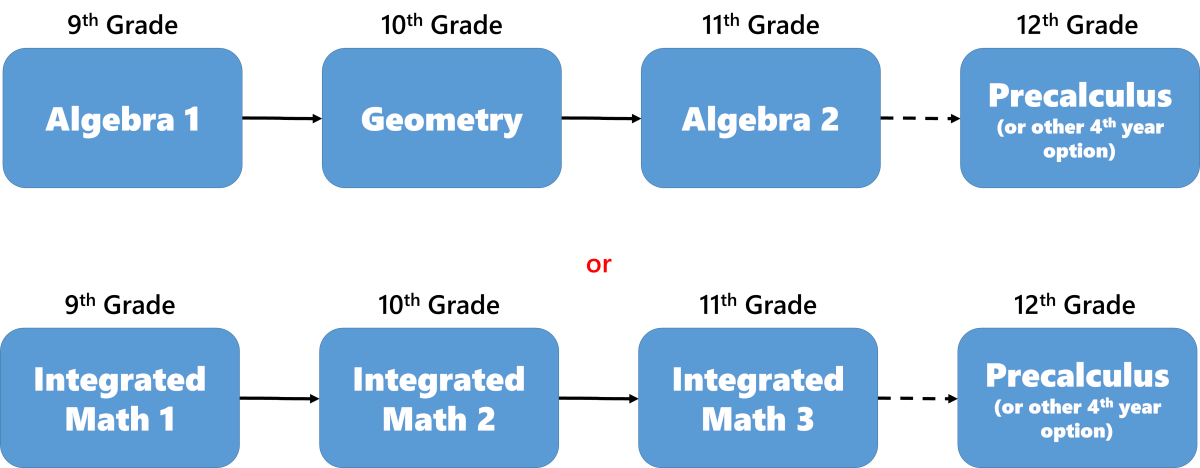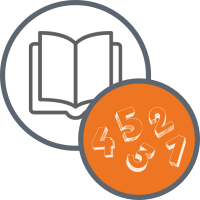You are here
Mathematics Pathways
Curriculum Support Menu
Mathematics Pathways
In general, mathematics "pathways" refers to sequences of courses or other learning opportunities that foster a students' mathematical development according to their interests with a goal of creating more opportunities for all. Pathways have become an area of national focus, driven in part by publications like NCTM's Catalyzing Change series of books, convenings of the Conference Board of Mathematical Sciences, and support of organizations like the Dana Center at the University of Texas at Austin.
Pathways Support from Colorado's Higher Education System
In Colorado's higher education system, a Math Pathways Task Force took on the issue of pathways and generated a report of recommendations at the conclusion of their work in 2016. These recommendations included defined pathways for calculus, statistics, and quantitative literacy, along with increased advising capacity and ongoing working groups. The General Education (GE) Council endorsed those math pathway recommendations in May of 2016 and the Colorado Commission on Higher Education (CCHE) unanimously endorsed the recommendations at their August 2016 meeting, with the note that "For middle and high schools this will be a big shift in thinking about how to prepare for higher education."
An Overview of Mathematics Pathways in High School
At PreK-12 in Colorado, pathways have become a common topic of discussion for mathematics teachers and specialists, with an increasing number of people looking to innovate and resolve long-standing issues affecting access, achievement, relevancy, and equity in mathematics learning, especially in high school.
For preschool through 12th grade, Colorado statutes require academic standards to describe what students should know and be able to do in mathematics. While there are progressions of learning inherent in these standards, described as coherence connections, the state does not dictate the content of individual courses or the construction of mathematics pathways. Generally, schools offer a daily math class or learning time in PreK-8, with the content of each class aligned to the academic standards for that grade.
In high school, opportunities to learn mathematics vary more. Most schools use the "traditional" sequence of Algebra 1, Geometry, and Algebra 2, while others offer an "integrated" sequence, which may be called Mathematics 1, Mathematics 2, and Mathematics 3, or something similar. Opportunities to learn mathematics vary even more for 11th and 12th graders, with some pursuing courses like precalculus or statistics, some taking college math courses through concurrent enrollment opportunities, some pursuing credit through AP courses, typically in calculus or statistics, and others earning math credit for courses like consumer math, computer-aided design and drafting, construction math, computer programming, nursing, or other postsecondary and workforce readiness (PWR) related classes for which a school district has determined some amount of math credit can be earned.

Typical traditional and integrated mathematics pathways.
In Catalyzing Change, NCTM makes the following key recommendation for the organization of high school mathematics:
High schools should offer continuous four-year mathematics pathways with all students studying mathematics each year, including two to three years of mathematics in a common shared pathway focusing on the Essential Concepts, to ensure the highest-quality mathematics education for all students. (p. 83)
NCTM outlines two possible pathways:
- Pathway A is the "Geometry First" pathway. The first semester of 9th grade would focus on Essential Concepts in geometry and measurement, followed by a focus on the Essential Concepts in statistics in the second semester of 9th grade. All 9th graders would start at the same point and build on their study of geometry and statistics in 8th grade. In the following three semesters (10th grade and the first half of 11th grade), students would focus on the Essential Concepts of algebra, building on their study of algebra in middle school. The remaining 1.5 years of high school math would include the study of mathematics in courses to serve students' future needs and interests.
- Pathway B is the "Integrated Approach" pathway. During the first year, students would study geometry and measurement, descriptive statistics, and graphing in the coordinate plane. Like Pathway A, all 9th graders would start at the same point. In the second year, students would continue their study of algebra, including exponential equations and functions. In the third year, students would analyze function families related to quadratic and exponential functions, as well as study statistical inference and probability. This could be a semester-long or year-long experience, depending on pacing. The remaining year or 1.5 years of high school math would include the study of mathematics in courses to serve students' future needs and interests.
Are pathways and tracking the same thing?
Pathways and tracking are not the same thing. In fact, pathways are usually described in direct contrast to tracking. With pathways, students self-select into courses or learning opportunities based on their interests. With tracking, students are placed into various "high" or "low" tracks based on their perceived ability. After decades of research showing that, in many cases, detracking improves student outcomes, the major organizations in mathematics education have taken positions against tracking:
What is Colorado's position on tracking and/or acceleration?
In Colorado, neither state statute nor State Board of Education policy promote or prohibit tracking, so it is left to local districts and schools to determine their own policies. C.R.S. 22-7-1013(2.5) requires that each local education provider review its procedures concerning academic acceleration for students. Accelerating students may or may not be done together with identifying students as gifted, or providing services to gifted students, which has its own set of statutes and recommendations. These are explained on the website for CDE's Office of Gifted Education and may be useful when considering district acceleration policies.
Since 2023, an independent, grassroots task force of Colorado educators has been working to make recommendations for math pathways in Colorado. In particular, they have focused on the opportunities for students in a student's final one or two years of high school, and what it means to "serve students' future needs and interests." For information about that task force and their progress, visit the pathways pages on the Colorado Math Leaders website.
If you are interested in innovating your mathematics pathways, or want to learn more, contact CDE's mathematics specialist using the contact info below. Pathways are a common topic of conversation among members of the Colorado Math Leaders and CCTM, as well as their national-level organizations NCSM and NCTM.
For further assistance, please contact:



Connect With Us





